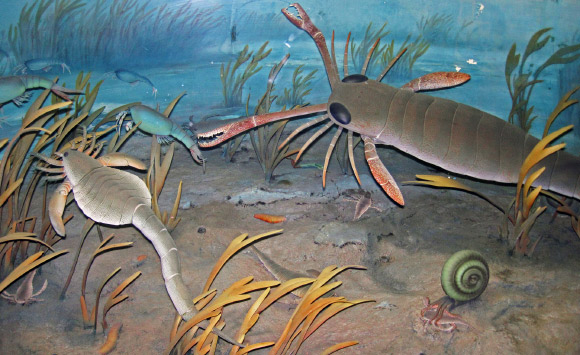The evolution of life on Earth has changed dramatically at tens of million-year time scales. However, the causal mechanisms of these changes remain unclear. In new research, scientists from Sorbonne Université, the University of Madison, the University of Sydney and the Université de Genève found evidence for 36-million-year cycles in marine animal fossil data over the last 250 million years. The authors also found similar, correlatable cycles in sea-level and Earth’s interior processes, suggesting that long-term marine biodiversity was paced by geodynamically driven global sea-level cycles.

Boulila et al. highlight a common, correlatable 36-million-year cycle in the diversity of marine genera as well as in tectonic, sea-level, and macrostratigraphic data over the past 250 million years of Earth history. Image credit: James St. John / CC BY 2.0.
Marine and land life evolves dramatically at tens of million-year time scales.
One measure of the changes in evolutionary tempo is the fluctuation in biodiversity, such as the well-documented fossil data on marine animal families and genera.
The biodiversity data are punctuated by five severe mass extinction events, or biotic crises, caused by various mechanisms.
Numerous studies have argued for or against the cyclic nature of biodiversity variations at tens of million-year time scales, but the inferred causes for the cyclic variations from external and/or Earth’s internal processes have remained conjectural.
“In terms of tectonics, the 36-million-year cycle marks alterations between faster and slower seafloor spreading, leading to cyclical depth changes in ocean basins and in the tectonic transfer of water into the deep Earth,” said University of Sydney’s Professor Dietmar Müller.
“These in turn have led to fluctuations in the flooding and drying up of continents, with periods of extensive shallow seas fostering biodiversity.”
Professor Müller and colleagues based their findings on the discovery of strikingly similar cycles in sea-level variations, Earth’s interior mechanisms and marine fossil records.
They now have overwhelming evidence that tectonic cycles and global sea level change driven by Earth’s dynamics have played a crucial role in shaping the biodiversity of marine life over millions of years.
“This research challenges previous ideas about why species have changed over long periods,” Professor Müller said.
“The cycles are 36 million years long because of regular patterns in how tectonic plates are recycled into the convecting mantle, the mobile part of the deep Earth, similar to hot, thick soup in a pot, that moves slowly.”
“The Cretaceous Winton Formation in Queensland serves as a prime example of how sea-level changes have shaped ecosystems and influenced biodiversity in Australia.”
“The formation, renowned for its collection of dinosaur fossils and precious opal, provides a valuable window into a time when much of the Australian continent was flooded.”
“As sea levels rose and fell, the flooding of the continent created expanding and contracting ecological recesses in shallow seas, providing unique habitats for a wide range of species.”
“The Cretaceous Winton Formation stands as a testament to the profound impact of these sea-level changes, capturing a snapshot of a time when Australia’s landscape was transformed and fascinating creatures roamed the land.”
The team’s results appear in the Proceedings of the National Academy of Sciences.
_____
Slah Boulila et al. 2023. Earth’s interior dynamics drive marine fossil diversity cycles of tens of millions of years. PNAS 120 (29): e2221149120; doi: 10.1073/pnas.2221149120







